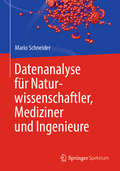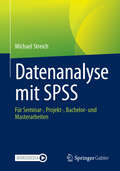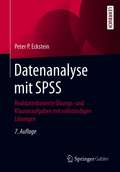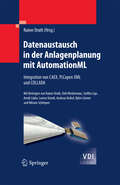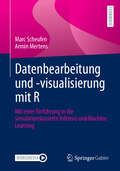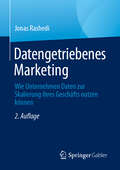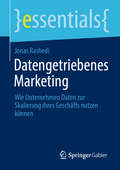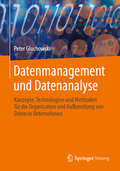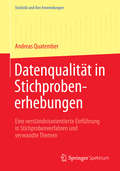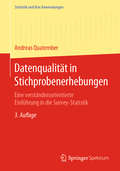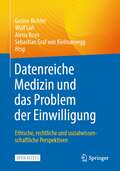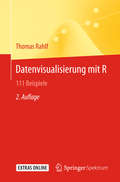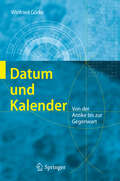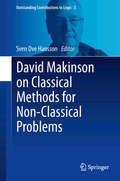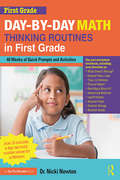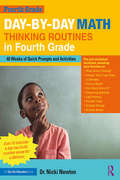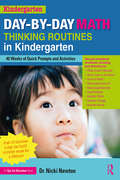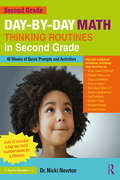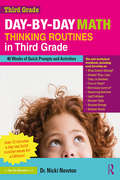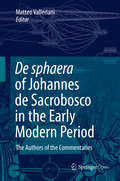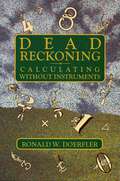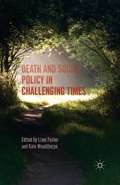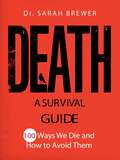- Table View
- List View
Datenanalyse für Naturwissenschaftler, Mediziner und Ingenieure
by Mario SchneiderDieses Buch bietet Ihnen eine verständlich vermittelte Ausgangsbasis für die praktische Anwendung datenanalytischer Methoden, die sinnvolle Interpretation von Daten und die Ableitung von Informationen. Dabei setzt dieses Buch anstelle langer mathematischer Herleitungen und Beweise auf konkrete Beispiele, die jeweils Schritt für Schritt nachvollzogen werden. Die ausgewählten Beispieldaten werden mit Hilfe von Excel analysiert und das Erlernte kann anhand von Übungsaufgaben überprüft werden. Zusätzlich können Sie in Onlinevideos die Rechenschritte nachvollziehen und parallel in Excel mitrechnen. Damit liefert Ihnen dieses Buch nicht nur das für die wissenschaftliche Praxis notwendige Basiswissen der Datenanalyse, sondern bietet gleichermaßen das Fundament für einen souveränen Umgang mit den entsprechenden Instrumenten. Dieses Buch unterstützt somit Naturwissenschaftler, Mediziner und Ingenieure in Studium und Praxis und bietet einen leichten Einstieg in die statistische Datenanalyse und ihre Anwendung in Excel.
Datenanalyse mit SPSS: Für Seminar-, Projekt-, Bachelor- und Masterarbeiten
by Michael StreichDieses Buch richtet sich an Studentinnen und Studenten, die im Rahmen ihrer Seminar-, Projekt-, Bachelor- oder Masterarbeit quantitative Daten erheben. Neben deskriptiven Analysen sind in solchen Situationen zumeist induktive statistische Verfahren gefordert, die auf den ersten Blick teilweise relativ komplex erscheinen. In diesem Buch werden typische Verfahren eingeordnet und inhaltlich erläutert. Neben einer einfachen Einführung werden im Nachgang vertiefende Analysen vorgestellt. Alle Verfahren werden anhand von Beispielen auf Basis der Statistiksoftware IBM SPSS® dargestellt, die einen sehr einfachen Zugang auch zu komplexeren Verfahren bietet. Dabei werden die Beispiele, nach einer Einführung in das Programm als solches, systematisch Schritt für Schritt bearbeitet, so dass auch eigene Analyse im Rahmen schriftlicher Arbeiten problemlos vorgenommen werden können.
Datenanalyse mit SPSS: Realdatenbasierte Übungs- und Klausuraufgaben mit vollständigen Lösungen
by Peter P. EcksteinPeter P. Eckstein bietet in diesem Lehrbuch eine Vielzahl von Übungs- und Klausuraufgaben zur statistischen Datenanalyse mit SPSS an. Die Aufgaben sind nach inhaltlichen Schwerpunkten geordnet und decken jedes Anspruchsniveau ab. Basis sind reale Daten, die im Kontext von praktischen Problemstellungen der empirischen Wirtschafts- und Sozialforschung erhoben wurden. Vollständige und ausführliche Lösungen zu allen Aufgaben führen zu einer hohen Verständlichkeit des komplexen Stoffes und ermöglichen somit ein effektives Selbststudium und eine gezielte Klausurvorbereitung.Für die siebte Auflage wurde das Aufgabenspektrum auf insgesamt 195 komplexe Problemstellungen mit zahlreichen theoretischen und praktischen Fragen erweitert. Alle in diesem Lehrbuch verwendeten SPSS-Dateien sind im Anhang aufgelistet und stehen im Internet zur freien Verfügung bereit.
Datenaustausch in der Anlagenplanung mit AutomationML: Integration von CAEX, PLCopen XML und COLLADA (VDI-Buch)
by Rainer DrathDas Buch gibt erstmals einen umfassenden Überblick über die Technologie AutomationML und die Integration von CAEX, COLLADA und PLCopen XML. Mit AutomationML soll die Interoperabilität zwischen digitalen Werkzeugen im Engineering-Prozess gefördert werden. Es ist das erste kostenfrei zugängliche, offene und XML-basierte Format, das übergreifend eine Vielzahl von Planungsaspekten kombiniert. Das Buch ist ein Gemeinschaftswerk des AutomationML-Konsortiums. Es wurde so konzipiert, dass es als Kompendium und zugleich als Entscheidungshilfe dienen kann.
Datenbearbeitung und -visualisierung mit R: Mit einer Einführung in die simulationsbasierte Inferenz und Machine Learning
by Marc Scheufen Armin MertensZiel des Lehrbuchs ist das Einüben und Umsetzen wichtiger Kompetenzen beim Datenhandling. So bestehen die ersten Schritte einer jeden empirischen Studie darin, die Daten für die eigene Analyse vorzubereiten. Das Bearbeiten (filtern, selektieren und ergänzen von Variablen) und das Strukturieren (gruppieren, zusammenfassen, zusammenfügen und bereinigen von Variablen und Datensätzen) der Daten legen dabei die fundamentale Grundlage jeder Empirie. Weiterführende Schritte zur Visualisierung und Analyse von Daten erlauben schließlich bedürfnisorientierte Gestaltungen der eigenen Datenanalyse. Aus didaktischer Sicht ist dieses Lehrbuch ein &“Mitmach&”-Buch. Die Leser und Leserinnen des Lehrbuchs können hierzu die verschiedenen Datensätze und Skripte von der Webseite des Verlages herunterladen und lernen von Beginn an und Schritt für Schritt, wie wir die Daten bearbeiten, strukturieren, visualisieren und analysieren.
Datengetriebenes Marketing: Wie Unternehmen Daten zur Skalierung ihres Geschäfts nutzen können
by Jonas RashediWir leben in einer Zeit, in der Daten immer mehr Relevanz besitzen, und zwar sowohl für die Geschäftsmodelle von Unternehmen im Gesamten als auch für einzelne Funktionsbereiche. Insbesondere im Marketing besitzen Daten eine hohe Relevanz, denn sie helfen, den Kunden zu verstehen und geeignete Maßnahmen abzuleiten. Doch viele Unternehmen tun sich schwer, einen Einstieg in das datengetriebene Marketing zu finden.Jonas Rashedi stellt mit diesem Buch einen Orientierungs- und Handlungsrahmen vor, der Unternehmen bei der Umsetzung und organisatorischen Verankerung eines datengetriebenen Marketings unterstützt. Der vorgestellte Prozess ist unabhängig von aktuell vorhandenen technologischen Lösungen gestaltet, sodass er für Unternehmen längerfristig Gültigkeit besitzt.
Datengetriebenes Marketing: Wie Unternehmen Daten zur Skalierung ihres Geschäfts nutzen können (essentials)
by Jonas RashediWir leben in einer Zeit, in der Daten immer mehr Relevanz besitzen, und zwar sowohl für die Geschäftsmodelle von Unternehmen im Gesamten als auch für einzelne Funktionsbereiche. Insbesondere im Marketing besitzen Daten eine hohe Relevanz, denn sie helfen, den Kunden zu verstehen und geeignete Maßnahmen abzuleiten. Doch viele Unternehmen tun sich schwer, einen Einstieg in das datengetriebene Marketing zu finden.Jonas Rashedi stellt mit diesem Buch einen Orientierungs- und Handlungsrahmen vor, der Unternehmen bei der Umsetzung und organisatorischen Verankerung eines datengetriebenen Marketings unterstützt. Der vorgestellte Prozess ist unabhängig von aktuell vorhandenen technologischen Lösungen gestaltet, sodass er für Unternehmen längerfristig Gültigkeit besitzt.
Datenmanagement und Datenanalyse: Konzepte, Technologien und Methoden für die Organisation und Aufbereitung von Daten in Unternehmen
by Peter GluchowskiDerzeit wird kaum noch ernsthaft bestritten, dass die Daten eines Unternehmens ein wichtiges Wirtschaftsgut darstellen und in erheblicher Weise zum Erfolg beitragen können. Allerdings gilt es, nicht nur den Wert der Daten zu erkennen, sondern diese auch in den zugehörigen Geschäftsprozessen gewinnbringend einzusetzen. Als zwingende Voraussetzung erweist sich dabei, eine organisatorische und technische Basis zu etablieren, die nachhaltig darauf ausgerichtet ist, die fachlichen Ausgabenstellungen bestmöglich zu unterstützen. Unter dem Oberbegriff Datenmanagement werden dazu diejenigen Führungs- und Durchführungstätigkeiten diskutiert, die einen tragfähigen Rahmen für den Umgang mit Daten in der Organisation aufspannen. Daneben erweisen sich vor allem die Verfahren zur Auswertung und Analyse der verfügbaren Datenbestände als leistungsfähige Instrumente, um langfristige Wettbewerbsvorteile zu erlangen. Vor diesem Hintergrund widmet sich das vorliegende Buch den stetig an Bedeutung gewinnenden Themenfeldern Datenmanagement und Datenanalyse, denen insbesondere im Rahmen der digitalen Transformation eine große Bedeutung zukommt.
Datenmodellierung in Data-Warehouse-Systemen: Konzepte, Technologien und Methoden für die Modellierung entscheidungsunterstützender Daten in Unternehmen
by Peter Gluchowski Melanie Pfoh Anja TetznerDieses Buch bietet wertvolle Unterstützung beim Aufbau und bei der Modellierung eines Data Warehouse (DW). Es führt praxisnah durch alle Phasen eines DW-Projekts – von der Anforderungsanalyse über die Datenmodellierung und Architektur bis hin zur praktischen Umsetzung. Leserinnen und Leser gewinnen ein tiefes Verständnis für bewährte Modellierungstechniken, die einen entscheidenden Faktor für die Struktur und den Erfolg eines DW darstellen. Ein besonderer Schwerpunkt liegt dabei auf der Definition von Regelwerken zur effektiven Erstellung semantischer und logischer Datenmodelle. Zudem werden nicht nur theoretische Grundlagen vermittelt, sondern auch praktisches Wissen zur Umsetzung – abgerundet durch eine realistische Fallstudie. Zielgruppe Praktiker*innen
Datenqualität in Stichprobenerhebungen: Eine verständnisorientierte Einführung in Stichprobenverfahren und verwandte Themen (Statistik und ihre Anwendungen)
by Andreas QuatemberDas Buch bietet eine verständnis- und anwendungsorientierte Einführung in verschiedene Stichprobendesigns, bestehend aus Auswahlverfahren und Schätzmethodik. Das Methodenverständnis wird unterstützt durch einfach nachvollziehbare und gerade dadurch besonders förderliche Beispiele. Dabei werden auch andere praxisrelevante Aspekte, welche sich auf die Qualität der gezogenen Schlussfolgerungen auswirken, nicht ausgeklammert: Behandelt werden unter anderem die Nonresponse-Thematik sowie die Anwendung von nichtzufälligen Auswahltechniken wie dem Quotenverfahren.
Datenqualität in Stichprobenerhebungen: Eine verständnisorientierte Einführung in die Survey-Statistik (Statistik und ihre Anwendungen)
by Andreas QuatemberDieses Buch beschäftigt sich mit den praktischen Fragestellungen statistischer Erhebungen (= Surveys) wie sie sich etwa in der empirischen akademischen Forschung, der offiziellen Statistik oder der kommerziellen Markt- und Meinungsforschung stellen:Wodurch unterscheiden sich verschiedene Stichprobendesigns?Wie sind sie praktisch umzusetzen (z. B. mit der Statistik-Freeware R)?Wie lassen sich die Daten- und die Ergebnisqualität beeinflussen?Wie kompensiert man Nonresponse? Wie können nichtzufällige Stichprobenverfahren und Big Data-Analysen im Zusammenhang mit den Aufgaben der Survey-Statistik funktionieren? Die Vermittlung des Methodenverständnisses wird unterstützt durch die verständnisorientierte Veranschaulichung der Basisideen. Diese Anschaulichkeit wird durch einfache und daher gut nachvollziehbare Beispiele gestützt. Für die vorliegende 3. Auflage wurde das Buch vollständig überarbeitet und inhaltlich unter anderem um die Betrachtung des Spannungsfeldes zwischen Survey-Theorie und -Praxis, die Grundlagen des Simulationsansatzes der Survey-Statistik und eine Auseinandersetzung mit den sich zunehmender Beliebtheit erfreuenden nichtzufälligen Stichprobenverfahren (inklusive den damit verwandten Big Data-Generierungsprozessen) erweitert. Jedes Kapitel wird zudem durch Aufgabenstellungen ergänzt, deren Umsetzung mit der Software R angeleitet wird.
Datenreiche Medizin und das Problem der Einwilligung: Ethische, rechtliche und sozialwissenschaftliche Perspektiven
by Alena Buyx Wulf Loh Gesine Richter Sebastian Graf von KielmanseggDieses Open Access Buch befasst sich mit praktischen Fragestellungen datenreicher internationaler Verbund-Forschung. Die datenreiche Medizin spielt in Diagnostik und Therapie eine immer größere Rolle – gerade angesichts immer leistungsfähigerer algorithmischer Mustererkennung. Mithilfe wachsender Datenbestände sind diese Algorithmen zunehmend in der Lage, Krankheitssymptome zu erkennen, diese mit anderen Daten in Beziehung zu setzen und so entweder bei der Suche nach Krankheitsursachen zu helfen oder Therapien zu optimieren. Vor dem Hintergrund dieser Entwicklungen vereint der Sammelband multidisziplinäre Perspektiven auf die datengetriebene medizinische Forschung mit besonderem Blick auf die Frage der Einwilligung in die Sekundärnutzung medizinischer Daten. Dabei werden zum einen ethische Überlegungen in den Bereichen Patientenautonomie und -wohlergehen, Privatheit und Datensicherheit, sowie Verantwortungsdiffusion aufgeworfen, als auch konkrete rechtliche Fragen hinsichtlich der DSGVO-Konformität erörtert. Sozialwissenschaftliche Studien zur Art und Form der Einwilligung sowie dem Patientenverhalten runden den Band ab.
Datenvisualisierung mit R: 111 Beispiele
by Thomas RahlfDieses Buch f#65533;hrt in die Grundlagen der Gestaltung von Pr#65533;sentationsgrafiken mit der Open Source Software R ein, die hinsichtlich der Visualisierungsm#65533;glichkeiten praktisch keine W#65533;nsche offen l#65533;sst und sich zunehmend als Standard im Bereich der Statistiksoftware etabliert. Anhand von 111 vollst#65533;ndigen Skript-Beispielen lernen Sie, wie Sie Balken- und S#65533;ulendiagramme, Bev#65533;lkerungspyramiden, Lorenzkurven, Streudiagramme, Zeitreihendarstellungen, Radialpolygone, Gantt-Diagramme, Profildiagramme, Heatmaps, Bumpcharts, Mosaik- und Ballonplots sowie eine Reihe verschiedener thematischer Kartentypen mit dem Base Graphics System von R erstellen. F#65533;r jedes Beispiel werden reale Daten verwendet sowie die Abbildung und deren Programmierung Schritt f#65533;r Schritt erl#65533;utert. Das Buch ist damit ein wertvolles Nachschlagewerk f#65533;r eine F#65533;lle von Anwendungsf#65533;llen der Datenvisualisierung, zu deren traditionellen Anwendungsbereichen in Wissenschaft und Marketing vermehrt auch neue Gebiete wie Big- Data-Analysen oder Datenjournalismus hinzukommen. In der vorliegenden Auflage wurden Beispiele zu Cartogrammen, Chord-Diagrammen und Netzwerken sowie ein neues Kapitel zu interaktiven Visualisierungen mit Javascript aufgenommen. Der Autor Thomas Rahlf arbeitet als Direktor in der Gruppe Qualit#65533;ts- und Verfahrensmanagement bei der Deutschen Forschungsgemeinschaft und ist Lehrbeauftragter an der Universit#65533;t Bonn. Er hat #65533;ber Methodologien der Statistik und #65533;konometrie promoviert, ist Mitglied im Editorial Board der Zeitschrift Cliometrica und Herausgeber einer Historischen Statistik von Deutschland. Den Themen Open Source, Datendesign und -visualisierung gilt seit vielen Jahren sein Interesse.
Datum und Kalender: Von der Antike bis zur Gegenwart
by Winfried GörkeNach einer Einführung in das Kalenderwesen erläutert der Autor Alternativen zum gregorianischen Kalender. Er präsentiert verschiedene Kalendersysteme wie den europäischen, den japanischen, chinesischen und den jüdischen Kalender und erläutert anhand der Oster-Berechnung die Methoden der Informatik, die für die Festlegung kalenderabhängiger Festtage von Bedeutung sind. Darüber hinaus stellt er eine Reihe von Vorschlägen zur Verbesserung von Kalendern vor.
David Makinson on Classical Methods for Non-Classical Problems (Outstanding Contributions to Logic #3)
by Sven Ove HanssonThe volume analyses and develops David Makinson's efforts to make classical logic useful outside its most obvious application areas. The book contains chapters that analyse, appraise, or reshape Makinson's work and chapters that develop themes emerging from his contributions. These are grouped into major areas to which Makinsons has made highly influential contributions and the volume in its entirety is divided into four sections, each devoted to a particular area of logic: belief change, uncertain reasoning, normative systems and the resources of classical logic. Among the contributions included in the volume, one chapter focuses on the "inferential preferential method", i. e. the combined use of classical logic and mechanisms of preference and choice and provides examples from Makinson's work in non-monotonic and defeasible reasoning and belief revision. One chapter offers a short autobiography by Makinson which details his discovery of modern logic, his travels across continents and reveals his intellectual encounters and inspirations. The chapter also contains an unusually explicit statement on his views on the (limited but important) role of logic in philosophy.
Day-by-Day Math Thinking Routines in Fifth Grade: 40 Weeks of Quick Prompts and Activities
by Nicki NewtonDay-by-Day Math Thinking Routines in Fifth Grade helps you provide students with a review of the foundational ideas in math, every day of the week! Based on the bestselling Daily Math Thinking Routines in Action, the book follows the simple premise that frequent, rigorous, engaging practice leads to mastery and retention of concepts, ideas, and skills. These worksheet-free, academically rigorous routines and prompts follow grade level priority standards and include whole group, individual, and partner work. The book can be used with any math program, or for small groups, workstations, or homework. Inside you will find: 40 weeks of practice 1 activity a day 200 activities total Answer Key For each week, the Anchor Routines cover these key areas: Monday: General Thinking Routines; Tuesday: Vocabulary; Wednesday: Place Value; Thursday: Fluency; and Friday: Problem Solving. Get your students’ math muscles moving with the easy-to-follow routines in this book!
Day-by-Day Math Thinking Routines in First Grade: 40 Weeks of Quick Prompts and Activities
by Nicki NewtonDay-by-Day Math Thinking Routines in First Grade helps you provide students with a review of the foundational ideas in math, every day of the week! Based on the bestselling Daily Math Thinking Routines in Action, the book follows the simple premise that frequent, rigorous, engaging practice leads to mastery and retention of concepts, ideas, and skills. These worksheet-free, academically rigorous routines and prompts follow the grade level priority standards and include whole group, individual, and partner work. The book can be used with any math program, or for small groups, workstations, or homework. Inside you will find: 40 weeks of practice 1 activity a day 200 activities total Answer Key For each week, the Anchor Routines cover these key areas: Monday: General Thinking Routines; Tuesday: Vocabulary; Wednesday: Place Value; Thursday: Fluency; and Friday: Problem Solving. Get your students’ math muscles moving with the easy-to-follow routines in this book!
Day-by-Day Math Thinking Routines in Fourth Grade: 40 Weeks of Quick Prompts and Activities
by Nicki NewtonDay-by-Day Math Thinking Routines in Fourth Grade helps you provide students with a review of the foundational ideas in math, every day of the week! Based on the bestselling Daily Math Thinking Routines in Action, the book follows the simple premise that frequent, rigorous, engaging practice leads to mastery and retention of concepts, ideas, and skills. These worksheet-free, academically rigorous routines and prompts follow the grade level priority standards and include whole group, individual, and partner work. The book can be used with any math program, or for small groups, workstations, or homework. Inside you will find: 40 weeks of practice 1 activity a day 200 activities total Answer Key For each week, the Anchor Routines cover these key areas: Monday: General Thinking Routines; Tuesday: Vocabulary; Wednesday: Place Value; Thursday: Fluency; and Friday: Problem Solving. Get your students’ math muscles moving with the easy-to-follow routines in this book!
Day-by-Day Math Thinking Routines in Kindergarten: 40 Weeks of Quick Prompts and Activities
by Nicki NewtonDay-by-Day Math Thinking Routines in Kindergarten helps you provide students with a review of the foundational ideas in math, every day of the week! Based on the bestselling Daily Math Thinking Routines in Action, the book follows the simple premise that frequent, rigorous, engaging practice leads to mastery and retention of concepts, ideas, and skills. These worksheet-free, academically rigorous routines and prompts follow the kindergarten priority standards and include whole group, individual, and partner work. The book can be used with any math program, or for small groups, workstations, or homework. Inside you will find: 40 weeks of practice 1 activity a day 200 activities total Answer Key For each week, the Anchor Routines cover these key areas: Monday: General Thinking Routines; Tuesday: Vocabulary; Wednesday: Place Value; Thursday: Fluency; and Friday: Problem Solving. Get your students’ math muscles moving with the easy-to-follow routines in this book!
Day-by-Day Math Thinking Routines in Second Grade: 40 Weeks of Quick Prompts and Activities
by Nicki NewtonDay-by-Day Math Thinking Routines in Second Grade helps you provide students with a review of the foundational ideas in math, every day of the week! Based on the bestselling Daily Math Thinking Routines in Action, the book follows the simple premise that frequent, rigorous, engaging practice leads to mastery and retention of concepts, ideas, and skills. These worksheet-free, academically rigorous routines and prompts follow second grade level priority standards and include whole group, individual, and partner work. The book can be used with any math program, or for small groups, workstations, or homework. Inside you will find: 40 weeks of practice 1 activity a day 200 activities total Answer Key For each week, the Anchor Routines cover these key areas: Monday: Reasoning; Tuesday: Vocabulary; Wednesday: Place Value; Thursday: Fluency; and Friday: Problem Solving. Get your students’ math muscles moving with the easy-to-follow routines in this book!
Day-by-Day Math Thinking Routines in Third Grade: 40 Weeks of Quick Prompts and Activities
by Nicki NewtonDay-by-Day Math Thinking Routines in Third Grade helps you provide students with a review of the foundational ideas in math, every day of the week! Based on the bestselling Daily Math Thinking Routines in Action, the book follows the simple premise that frequent, rigorous, engaging practice leads to mastery and retention of concepts, ideas, and skills. These worksheet-free, academically rigorous routines and prompts follow grade level priority standards and include whole group, individual, and partner work. The book can be used with any math program, or for small groups, workstations, or homework. Inside you will find: 40 weeks of practice 1 activity a day 200 activities total Answer Key For each week, the Anchor Routines cover these key areas: Monday: General Thinking Routines; Tuesday: Vocabulary; Wednesday: Place Value; Thursday: Fluency; and Friday: Problem Solving. Get your students’ math muscles moving with the easy-to-follow routines in this book!
De sphaera of Johannes de Sacrobosco in the Early Modern Period: The Authors of the Commentaries
by Matteo VallerianiThis open access book explores commentaries on an influential text of pre-Copernican astronomy in Europe. It features essays that take a close look at key intellectuals and how they engaged with the main ideas of this qualitative introduction to geocentric cosmology. Johannes de Sacrobosco compiled his Tractatus de sphaera during the thirteenth century in the frame of his teaching activities at the then recently founded University of Paris. It soon became a mandatory text all over Europe. As a result, a tradition of commentaries to the text was soon established and flourished until the second half of the 17th century. Here, readers will find an informative overview of these commentaries complete with a rich context. The essays explore the educational and social backgrounds of the writers. They also detail how their careers developed after the publication of their commentaries, the institutions and patrons they were affiliated with, what their agenda was, and whether and how they actually accomplished it. The editor of this collection considers these scientific commentaries as genuine scientific works. The contributors investigate them here not only in reference to the work on which it comments but also, and especially, as independent scientific contributions that are socially, institutionally, and intellectually contextualized around their authors.
Dead Reckoning: Calculating Without Instruments
by Ronald W. DoerflerNo author has gone as far as Doerfler in covering methods of mental calculation beyond simple arithmetic. Even if you have no interest in competing with computers you'll learn a great deal about number theory and the art of efficient computer programming. —Martin Gardner
Death and Social Policy in Challenging Times
by Liam Foster Kate WoodthorpeThe study of death has the capacity to bring together a range of policy areas. Yet death is often overlooked within policy debates in the UK and beyond, and within gerontology. Bringing together a range of scholars engaged in policy associated with death, this collection provides a holistic account of how death factors in social policy. Within this, issues covered include inheritance, palliative care, euthanasia, funeral costs, bereavement support, marginalised deaths and disposal practices. At the heart of the book, the volume recognises that the issues identified are likely to intensify and expand over the next twenty years, as death rates continue to rise.
Death: A Survival Guide
by Sarah BrewerWe all have a 100% chance of dying--eventually. But what are the world's biggest killers? When are you most at risk? And what can you do to postpone the inevitable for as long as possible? Death: A Survival Guide offers a unique insight into the biggest threats to life and limb in the industrialized world. Sarah Brewer's comprehensive and thorough survey looks at 100 causes of death from the most common such as heart disease, smoking related deaths and domestic accidents to the unusual and downright bizarre lightning strikes and animal attacks. This fascinating--and occasionally sideways--look at death and dying will help you understand the most common causes of death and how each one affects the human body. "At a glance" statistics reveal who dies where, when and how often; lists of warning signs, symptoms and risk factors allow you to determine the chances of it happening to you; and finally case studies on prevention, treatment and cures describe the best steps you can take to avoid meeting your maker in this way.
